Journey to a remote planet then double back to check in on the latest stirrings of Comet 29P/Schwassmann-Wachmann before touching the finger of dawn.
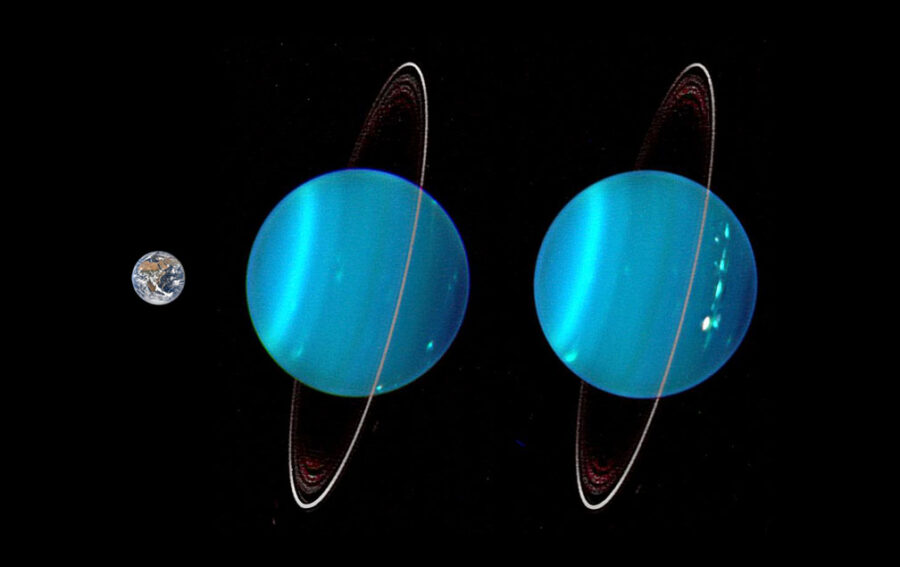
Lawrence Sromovsky, University of Wisconsin-Madison / W. W. Keck Observatory / NASA image of Earth
On the night of November 4–5, Uranus comes to opposition in a lonely corner of the sky just north of Cetus in Aries. On that date, Earth and the seventh planet pair up on the same side of the Sun and are closest for the year. Close is a relative term when it comes to astronomy: Uranus will stand 2.8 billion kilometers from Earth at opposition.
To feel the enormity of this distance, let's hop in the car for a drive. Traveling at a freeway speed of 80 miles an hour (around 130 km/h) and never stopping for bathroom breaks we'd arrive in about 2,550 years. Taking an airplane accelerates our arrival but not by much, with a one-way trip lasting 380 years. With travel untenable, we'll stick to binoculars and telescopes instead.
Point and go seek
In late October, the planet stands about 20° high in the eastern sky by 8:30 p.m. local daylight time. That changes to 7:30 p.m. when we return to standard time on November 7th. Fortunately, the Moon won't interfere until about November 9th, so for the next two weeks you'll have an opportunity to spot Uranus without optical aid.
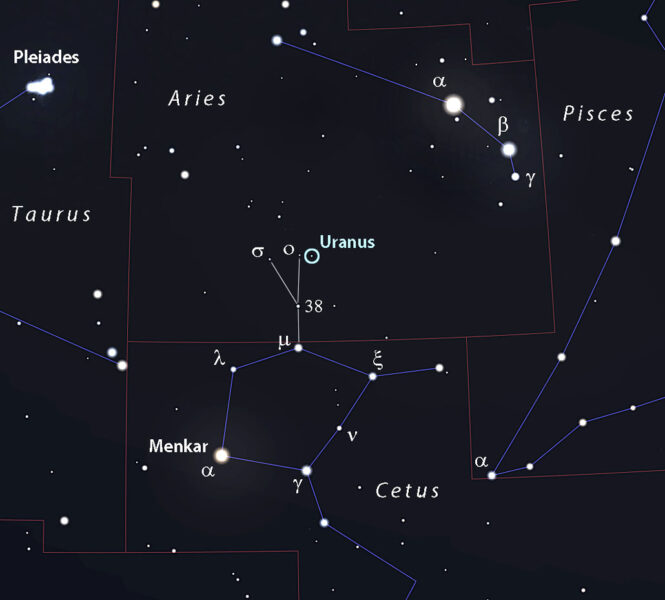
Stellarium
At magnitude 5.7 this won't be difficult from rural skies. Key to finding the planet is to connect it into a pattern with other nearby stars. The map at left shows its relation to Mu (μ) Ceti and the stars 38 Arietis, Sigma (σ) Arietis, and Omicron (ο) Arietis, which form a "Y." Uranus locates just west of this asterism. Be sure to look around rather than directly at the planet. This aligns the most night-sensitive part of your retina with your target in a ploy called averted vision.
In binoculars Uranus is a piece of cake. You just have to know where to point. The planet creeps slowly westward in retrograde motion for the remainder of the year. Covering just 2.3° from October 27th to December 31st — barely half a typical binocular field of view — makes it easy to keep track of.
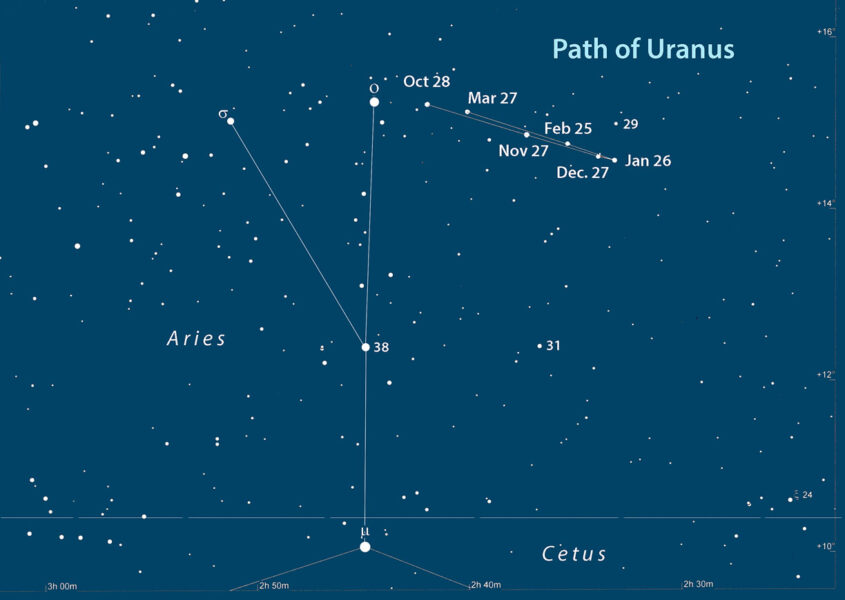
Megastar with permission
Only in a telescope does Uranus reveal its true nature as a planet, displaying a tiny 3.7-arcsecond-wide disk with magnifications of 100× and up. Just in case you needed more proof of the planet's remoteness, Uranus is four times the diameter of Earth but appears only twice the apparent size of Jupiter's moon Ganymede. Like Neptune, most observers report that the planet appears blue-green, a color due to methane gas in its mostly hydrogen-helium atmosphere. I see only the palest blue color when using magnifications of 245× and higher.
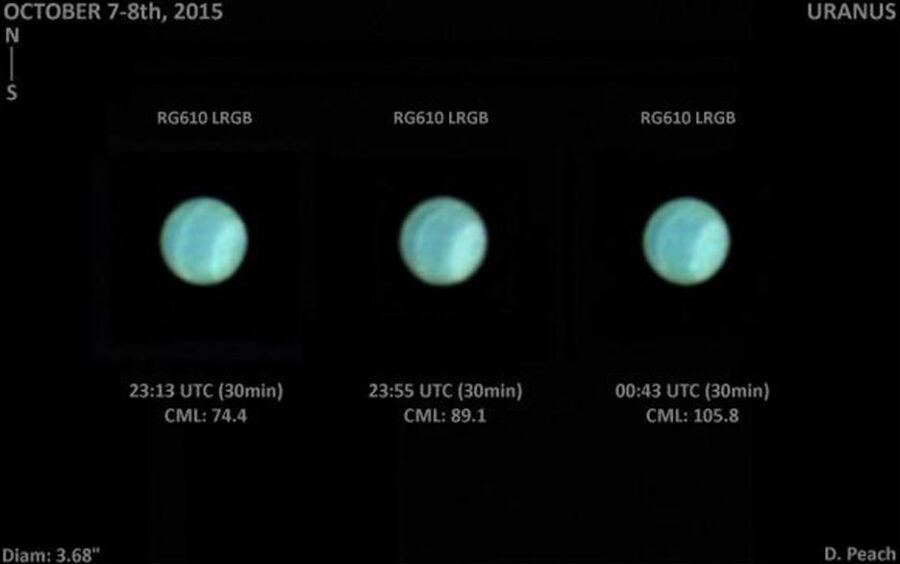
How you can contribute
I've never seen any disk detail, but other amateurs report discerning differences in shading between the equatorial and polar regions using 8-inch and larger instruments and magnifications north of 300×. Seeing must be near-perfect to make out such subtle stuff. Photographically, amateurs with 12-inch and larger telescopes have clearly recorded bright polar hoods and equatorial belts using near-infrared filters such as the Baader IR685.
In addition to near-infrared photography, Richard Schmude, remote planets coordinator with the Association of Lunar & Planetary Observers (ALPO), encourages observers to collect brightness measurements of Uranus using an astronomical camera and green filter at low magnification so as to include a field star for comparison.
"Another project amateurs may participate in is the collecting of brightness measurements of the four brightest moons of Uranus," said Schmude. "This is well within the reach of a 10-inch telescope and a CCD camera. They may show variability from rotation and secondly, they may show a brightness or color change as their orientation changes." You can send your observations to ALPO's Remote Planets Section (click on the link on the left-hand side) and to the British Astronomical Association (BAA).
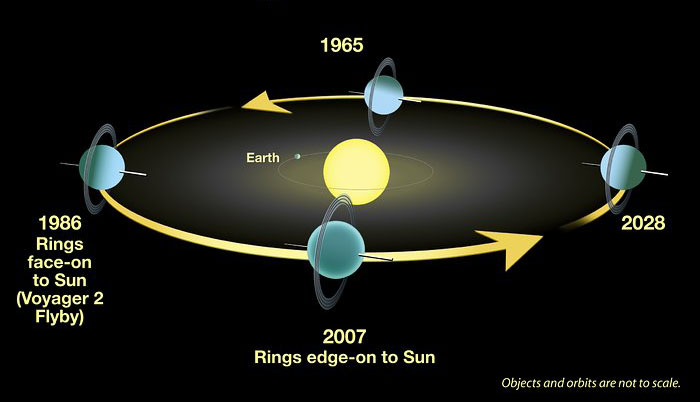
NASA / ESA / M. Showalter (SETI Institute)
While most of us will see a featureless disk, there is a way to perceive the planet's lopsided spin, caused by its axis tilted at 98°. Uranus rotates on its side like a tipped-over top. Since the planet's moons are coplanar with the equator, they don't swing from side to side as Jupiter's brightest moons do, but circle around the planet instead.
V101 Science
Two of the planet's 27 known moons are visible in 10-inch and larger telescopes — Titania at magnitude 13.9 and Oberon at 14.1. Look for them around the time of maximum elongation when their separations from Uranus are approximately 30″ and 40″, respectively. I see both faintly with averted vision in my 15-inch reflector at 245×, but 429× provides a much better view. Sky & Telescope's Moons of Uranus observing tool will help you find them.
As chillier weather moves in and the Sun sinks lower and lower, take heart. It's much worse at Uranus, where our star is little more than a blindingly bright dot barely resolvable with the naked eye and far stingier with its gifts. Let these cold facts motivate you to pay the planet a visit the next clear night.
Comet 29P rocks and rolls!

Eliot Herman
In late September we reported on one of 29P/Schwassmann-Wachmann's brightest outbursts in recent years. Richard Miles of the BAA believes it was "the most energetic of the past 40 years." At peak, this bomb of a comet became as bright as 10th magnitude with a distinct, disk-like coma and dense, bright core. Miles posits that the comet's violent outbursts are powered by liquid hydrocarbons that find their way to the surface through fissures and explode as cryovolcanoes. Dissolved gases rapidly expand and blast embedded dust into space to create a rapidly expanding coma.
Just when it seemed like 29P was "on the fade," its coma becoming ever more transparent, a new ~2.5-magnitude outburst occurred on October 23rd and brought the comet back to life. Now that we've entered a moonless spell, please take a look. A 10-inch telescope should still show this feisty, 60-kilometer-wide ice-ball as a small, fuzzy disk near the star Iota (ι) Aurigae. It appeared diffuse through my 15-inch on October 27.1 UT with a coma diameter of 2′ and magnitude around 11. Click here for a map.
Get your zodiacal light on
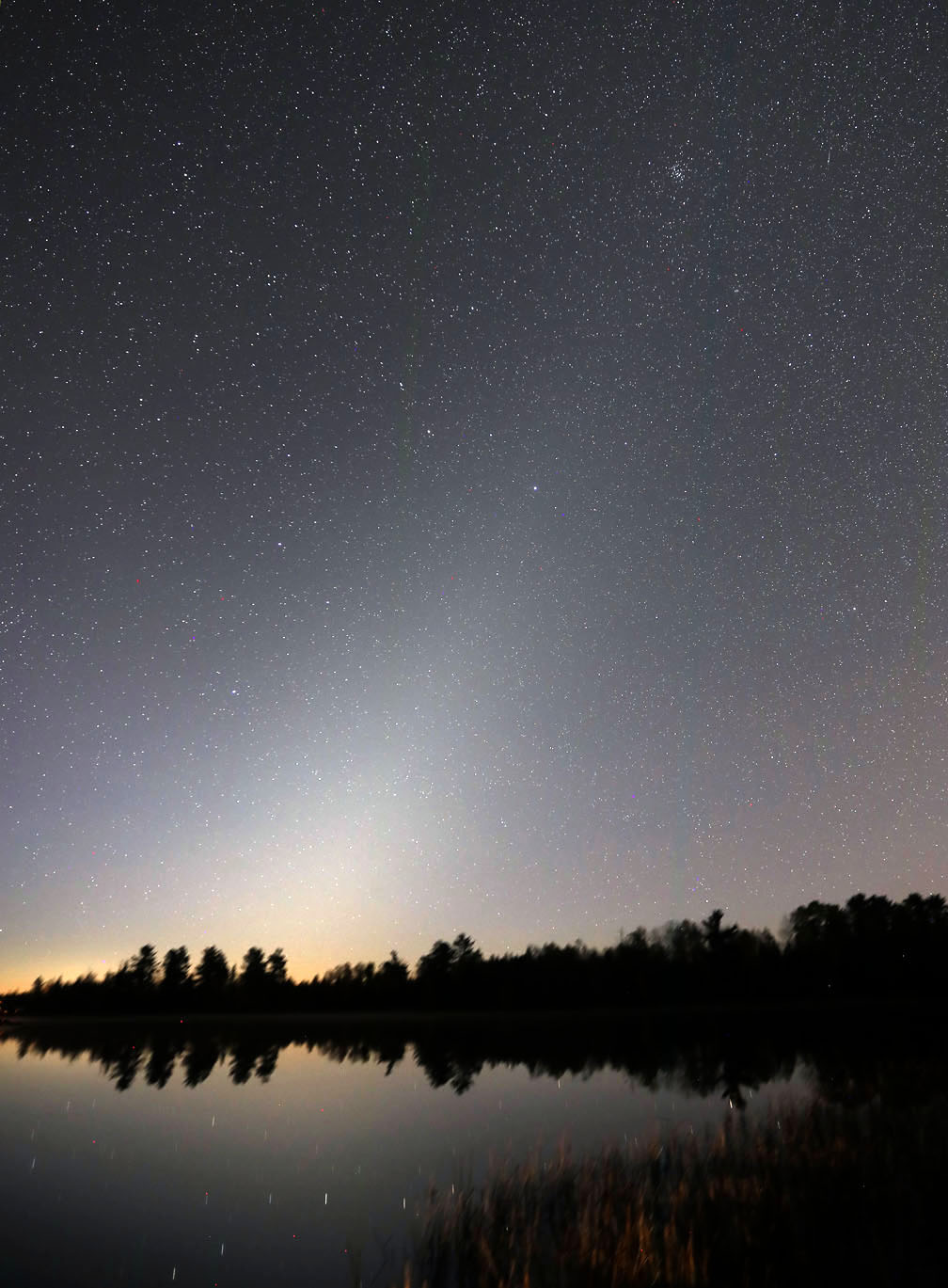
Bob King
Autumn mornings just before the start of dawn are perfect for seeking the largest single, naked-eye entity routinely visible in the solar system — the zodiacal light. I rose twice earlier this month and traced the enormous cone of interplanetary dusk from near the horizon across 75° of sky to where it softly brushed the winter Milky Way. New research indicates that its true source — long thought to be dust shaken off by comets and released during asteroid collisions — may actually be Martian dust.
What remains unknown is the ongoing mechanism for continuously removing the material and propelling it to escape velocity. No matter. Just enjoy the prettiest, grittiest, sleekest sight in the sky. Your best viewing time starts about an hour before and up to the start of dawn during the November 3–17 moonless window. Bonus! Stick around into early dawn on November 3rd, and you'll see a stunning conjunction of the old Moon and Mercury.
Go to our webpage on Uranus and Neptune to learn more about the ice giants and for extra charts. Get the November issue of Sky & Telescope for more fun observing tips on Uranus's opposition and other events.
 6
6









Comments
Chris-Schur
October 27, 2021 at 6:28 pm
Great write up Bob! did you actually take that zodiacal light shot from your backyard? impressive.
this also brings up an interesting question, has any amateur ever imaged the rings of Uranus? it would seem that with the appropriate IR filter these days that might just be possible.
You must be logged in to post a comment.
Bob KingPost Author
October 27, 2021 at 6:45 pm
Hi Chris,
So nice to hear from you and thanks! I took the zodiacal light photo from a little lake about 15 minutes north of where I live. The morning was perfectly still, and the light towered up. A most beautiful sight.
I've never seen an amateur image of the rings, but it sure sounds like a challenge waiting for you to attempt.
You must be logged in to post a comment.
Anthony Barreiro
October 29, 2021 at 6:15 pm
That is a beautiful image of the zodiacal light reaching up through Leo toward the Beehive Cluster. Thanks very much!
A tiny semantic quibble -- Uranus reveals it's planetary nature through binoculars. You just have to watch for several nights to detect the planet's movement relative to the background stars. 😉
You must be logged in to post a comment.
Bob KingPost Author
November 1, 2021 at 12:00 am
Dear Anthony,
Thank you for your kind words about the photo. I know you knew what I meant in writing what I did, but yes, strictly speaking, that would be a potential indicator of planethood, too. Bravo! Or . . . might it instead be an asteroid?
You must be logged in to post a comment.
Anthony Barreiro
November 1, 2021 at 3:16 pm
Asteroid, aka minor planet? (Sorry, couldn't resist).
You must be logged in to post a comment.
Nakedgun
November 21, 2021 at 11:37 pm
Bob,
Thanks for the article.
I have a question about the link after your piece to the Uranus / Neptune webpage. The link is nice, but how would one navigate to that page without it? I've tried to find it previously, without success.
You must be logged in to post a comment.
You must be logged in to post a comment.